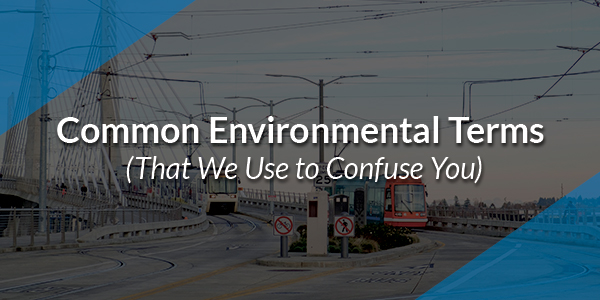
By Josh Channell, AICP, LEED-AP
Acronyms, permits, and documents… oh my! There’s a lot to navigate when it comes to environmental terms. For those of us who deal with this language daily, these are second nature. However, to someone who doesn’t work in the environmental realm these can be quite confusing! Contrary to the title of this blog post, these terms aren’t intended to confuse you. Check out this short list of some of the most common environmental terms we use on transportation projects.
NEPA
National Environmental Policy Act (of 1969) – Federal agencies must evaluate the environmental impacts of their projects. Applies to many projects receiving Federal money or that require Federal decisions (including some Federal permits)
Most Common Federal Permits:
Section 401: Clean Water Act – Requires water quality permits issued by State (NPDES permits)
Section 404: Clean Water Act – Requires permits for filling of wetlands & waters (Army Corps)
Section 408: Rivers and Harbors Act of 1899 – regulates work in navigational channels (Army Corps, Coast Guard) and work that affects flood control levees (Army Corps)
Document Types:
CE: Categorical Exclusion – brief documentation that an action fits into categories of projects that will not result in significant environmental impacts – excluded from NEPA. Most Departments of Transportation and Local Agency actions (planning, maintenance, cleaning, resource allocation, etc.)
PCE: Programmatic Categorical Exclusion – Authorizes some Departments of Transportation (WSDOT, ODOT, Caltrans, others) to determine and approve CEs on behalf of FHWA. Generally, a short report is prepared (sometimes with additional technical reports) documenting why a project does not require more extensive analysis.
EA: Environmental Assessment: A brief environmental document used to determine whether a federal action will result in significant environmental impacts. An EA may result in a Finding of No Significant Impact (FONSI) or the preparation of an EIS.
EIS: Environmental Impact Statement: The longest format environmental document for NEPA. Requires extensive environmental analysis and is used when significant environmental impact will result from the action.
Cultural Resources and Parks
Section 106: National Historic Preservation Act. Requires protection of cultural resources for all projects involving Federal money or approvals.
SHPO: State Historic Preservation Office – An office found within each state government that administers programs to protect cultural resources protected by federal law.
Section 4(f): US DOT Act – prohibits USDOT agencies from using land from publicly owned parks, recreation areas (including recreational trails), wildlife and water fowl refuges, or public and private historic properties, unless there is no feasible and prudent alternative to that use and the action includes all possible planning to minimize harm.
de minimis: Specific 4(f) term to indicate that impacts are minor or have been adequately mitigated such that harm has been minimized.
Section 6(f): A section of the Land & Water Conservation Fund Act, which is a grant program for park improvements. Upon receiving a grant, a park is protected by the provisions of Section 6(f).
Biology: Fish, Birds, Bunnies, Bugs, Bats, etc:
ESA: Endangered Species Act. Section 7 of the Act requires Federal agencies to consult with US Fish & Wildlife Service (USFWS) and National Marine Fisheries Service (NMFS) to ensure that their actions won’t jeopardize the continued existence of threatened or endangered species, or adversely modify their critical habitat.
MBTA: Migratory Bird Treaty Act. Protects birds during migration and nesting.
Community:
Environmental Justice: Evaluation of whether the project disproportionately affects minority, low income, vulnerable communities. Largely based on census data.
This list was originally presented by Josh along with Daniel Ohrn (ODOT) at the American Council of Engineering Companies/Oregon Department of Transportation Region 2 Monthly Lunch and Learn. The topic – “Stress-Free Environmental: Or… How to Set Up Your Project to Avoid Stepping In It!”
About the Author

Josh Channell, AICP, LEED-AP has been with Parametrix since February 2018 and is an urban transportation planner and environmental specialist in the Portland office. He’s excited that he gets to work every day helping clients consider how to make their transportation systems more equitable, more beautiful and environmentally sustainable, and safer and more efficient to navigate. Josh’s professional work includes transportation and NEPA environmental planning for multimodal projects, including bicycle/pedestrian facilities, expressways and parkways, high-occupancy vehicle and toll (HOV/HOT) lane additions, interchanges, high-speed rail, and transit capacity expansions.

